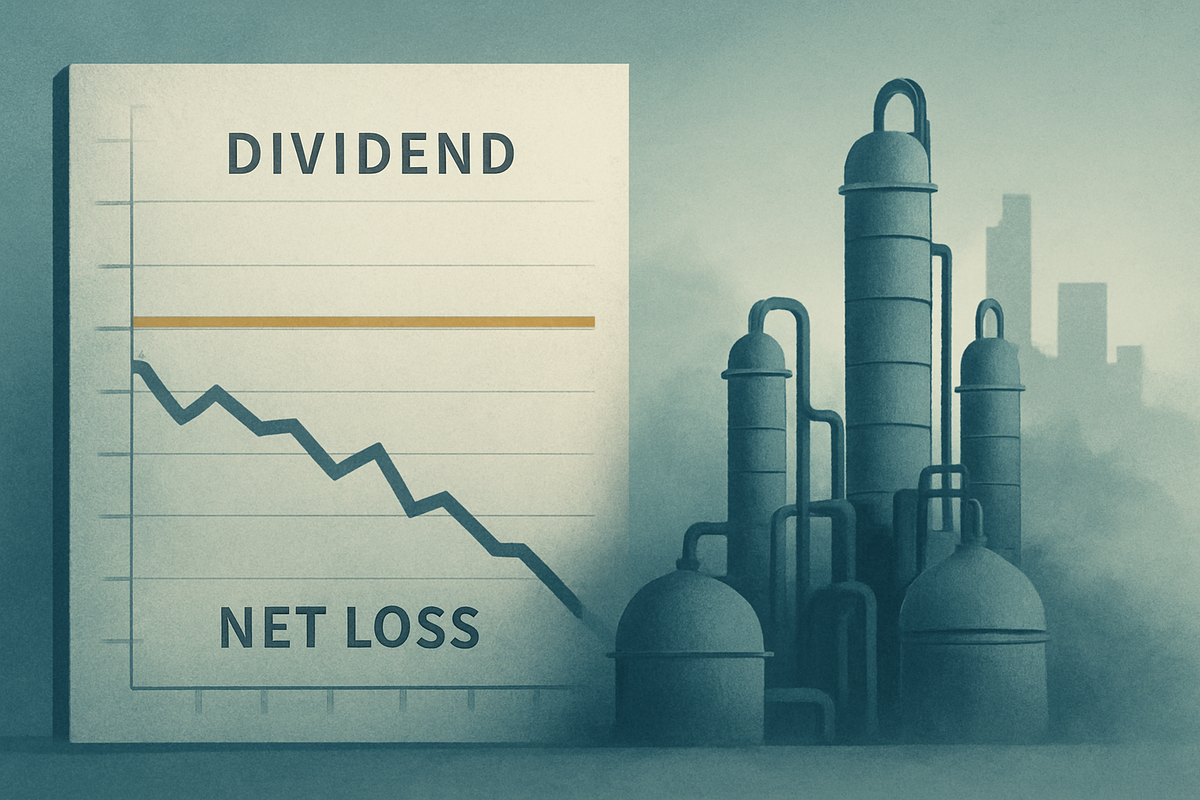
Dallas, TX – November 6, 2025 – Valhi, Inc. (NYSE: VHI), a diversified holding company, has declared its regular quarterly dividend of $0.08 per share on its common stock. This announcement, made on November 6, 2025, with a record date of November 21, 2025, and a payment date of December 18, 2025, comes even as the company reported a significant net loss for the third quarter of 2025. The decision to maintain a consistent payout amidst operational headwinds highlights a strategic commitment to shareholder returns, potentially signaling management's confidence in the company's long-term resilience and the underlying strength of its diversified portfolio.
The concurrent release of Valhi's third-quarter financial results, which showed a net loss attributable to stockholders of $22.2 million, or $0.78 per share, for Q3 2025, has drawn particular attention. This contrasts sharply with a net income of $57.5 million in the same period of 2024. Despite the downturn, primarily driven by its Chemicals Segment, Valhi's board has chosen to prioritize a steady return to investors, a move that could both reassure income-focused shareholders and prompt broader market scrutiny regarding the sustainability of this strategy.
Detailed Coverage: A Dividend Maintained Against the Odds
Valhi, Inc.'s (NYSE: VHI) recent declaration reaffirms a long-standing commitment to its shareholders. The $0.08 per share quarterly dividend, consistently paid throughout 2025, maintains an annual payout of $0.32 per share. This stability is notable, given the company's report of a net loss for the third quarter of 2025 and a cumulative net loss for the first nine months of the year. The decision was made by Valhi's board of directors, with Bryan A. Hanley, Senior Vice President and Treasurer, serving as a key contact for investor relations.
The timing of this dividend declaration, on November 6, 2025, coincided directly with the release of Valhi's Q3 2025 financial results, which revealed a substantial net loss. The Chemicals Segment, a significant part of Valhi's business primarily through its subsidiary Kronos Worldwide (NYSE: KRO), was the main culprit, experiencing a 7% decline in titanium dioxide (TiO2) selling prices and incurring $27 million in unabsorbed fixed production costs. For the first nine months of 2025, Valhi recorded a net loss of $4.4 million, a stark reversal from the prior year's net income.
Despite these operational challenges, the company's consistent dividend history—totaling 147 payments since 1987—underscores a strategic prioritization of shareholder value. This "stubborn dividend consistency" suggests that management views the current operational struggles as temporary or believes the company's diversified portfolio provides sufficient buffer. While the dividend yield remains attractive at approximately 8.5%, the payout amidst net losses raises questions for income-focused investors about the long-term sustainability if operational headwinds persist.
The market's initial reaction appears to be one of cautious observation. While a dividend declaration typically signals financial health, the concurrent announcement of a net loss tempers any celebratory sentiment. Analysts are likely to scrutinize the company's cash flow and balance sheet closely to determine if the dividend is genuinely supported by operational cash generation or if it is drawing down reserves, potentially impacting future financial flexibility.
Company Impact: Winners, Losers, and Strategic Implications
Valhi, Inc.'s (NYSE: VHI) decision to maintain its dividend payout despite a Q3 2025 net loss presents a nuanced picture for the company and its stakeholders. For Valhi itself, this move is a double-edged sword. On one hand, it reinforces its image as a reliable dividend payer, a characteristic that can attract and retain income-focused investors, thereby potentially stabilizing its stock price. On the other hand, continuing dividend distributions during a period of unprofitability can strain liquidity and reduce retained earnings, which are crucial for reinvestment, debt reduction, and weathering future economic downturns. This strategy could signal management's confidence in a swift recovery or the underlying strength of its diversified assets, but it also carries the risk of depleting capital necessary for long-term growth.
Shareholders who prioritize consistent income streams are the immediate winners. Retirees and investors utilizing dividend reinvestment plans (DRIPs) will appreciate the steady payouts, which offer a sense of financial stability. However, growth-oriented shareholders might view this strategy with skepticism. The capital allocated to dividends could otherwise be reinvested in the business to fuel innovation, expansion, or debt reduction, potentially leading to greater capital appreciation in the long run. If the dividend proves unsustainable and is eventually cut, it could trigger a significant sell-off and erode investor confidence.
The ripple effect on other companies in Valhi's sector, particularly its subsidiaries Kronos Worldwide (NYSE: KRO) and NL Industries (NYSE: NL), is also noteworthy. Kronos Worldwide (NYSE: KRO), a major international producer of titanium dioxide, and NL Industries (NYSE: NL), involved in component products and chemicals, have also declared consistent quarterly dividends. This suggests a unified corporate philosophy within the Valhi (NYSE: VHI) group to prioritize shareholder distributions. This consistency could set an expectation for other companies in the chemicals or diversified holding sectors, potentially pressuring them to maintain their own dividends even during challenging periods. However, it also highlights the challenge of balancing shareholder returns with the need for capital preservation during cyclical downturns.
Wider Significance: Industry Trends and Historical Context
Valhi, Inc.'s (NYSE: VHI) unwavering dividend policy amidst a net loss provides a compelling case study within broader industry trends, particularly for diversified holding companies and the chemicals sector. For diversified holding companies, maintaining a dividend during a downturn in one segment often reflects the ability to leverage stronger performance in other areas. Valhi's Component Products segment showed improvement, and its Real Estate segment delivered solid income, providing a buffer against the struggles of its Chemicals Segment. This diversification strategy aims to project stability and appeal to income-seeking investors, even when a core business unit faces significant headwinds.
The chemicals sector, however, presents a contrasting narrative. The industry is currently experiencing a "prolonged downcycle," characterized by weakened economic growth, geopolitical tensions, and persistent overcapacity, especially in basic chemicals like titanium dioxide (TiO2). This environment has led to downward revisions in global chemical production growth forecasts for 2025 and 2026. Many chemical companies, such as Huntsman (NYSE: HUN), have responded by significantly reducing their dividends to preserve financial flexibility. Valhi's subsidiary, Kronos Worldwide (NYSE: KRO), as a major TiO2 producer, is directly exposed to these challenges. Therefore, Valhi's sustained dividend, through Kronos, goes against the prevailing trend and could be interpreted as an aggressive stance or a strong belief in a rapid rebound for its chemical operations.
Regulatory implications for dividend payments are generally focused on ensuring they are paid from distributable profits or accumulated retained earnings, not from capital. While Valhi reported a net loss for Q3 2025, its ability to declare a dividend implies it still possesses positive accumulated retained earnings from previous profitable periods. However, continued losses while distributing dividends would attract increasing scrutiny from financial analysts and could raise concerns about the company's long-term solvency if not supported by strong cash flow.
Historically, companies maintaining dividends during challenging periods is not unprecedented. Some companies, especially those with "dividend aristocrat" status, go to great lengths to preserve their payout records to signal confidence and retain income-focused investors. For instance, during the 2008-2009 financial crisis, while many companies cut dividends, some in defensive sectors like utilities (e.g., Duke Energy (NYSE: DUK)) or consumer staples (e.g., Kimberly-Clark (NYSE: KMB)) managed to sustain or even increase payouts. However, examples like General Motors (GM) in the mid-2000s, which eventually suspended its dividend before bankruptcy, serve as a cautionary tale for unsustainable payouts. Valhi's situation appears to be an attempt to project stability through a cyclical downturn, but its sustainability will heavily depend on the turnaround of its Chemicals Segment.
What Comes Next: Navigating Future Possibilities
Valhi, Inc.'s (NYSE: VHI) path forward, following its steadfast dividend declaration amidst a net loss, will be closely watched by investors and industry observers. In the short term, the company's financial health will hinge on its ability to manage liquidity and stem the losses, particularly within its Chemicals Segment. While the low payout ratio offers some comfort regarding dividend coverage, sustained unprofitability will inevitably pressure cash reserves. Valhi's recent capital management, including debt reduction and the issuance of Kronos (NYSE: KRO) senior secured notes, indicates a focus on financial discipline, but these efforts could be strained if the downturn is prolonged.
Long-term prospects for Valhi are intricately tied to the strategic optimization of its diversified subsidiaries. The cyclical nature of the Chemicals Segment, exposed to global economic fluctuations, remains a significant risk. Valhi's recent acquisition of the remaining 50% interest in Louisiana Pigment Company, L.P. (LPC) for $185 million, making it a wholly-owned subsidiary of Kronos Worldwide (NYSE: KRO), represents a crucial strategic pivot. This move aims to consolidate dominance in TiO2 production, increase capacity, and improve the cost structure—a vital adaptation in a market characterized by overcapacity and declining prices. Further adaptations might include intensified cost optimization, exploring specialized TiO2 products, and leveraging market share gains in regions imposing tariffs on Chinese exports.
Emerging market opportunities for Valhi primarily lie in the long-term growth of the global titanium dioxide market, projected to expand from $22.5 billion in 2025 to over $39.54 billion by 2035. Increased demand from paints, coatings, construction, and automotive industries, particularly in the Asia Pacific and North American regions, could fuel a recovery. However, challenges persist, including a potential prolonged global economic slowdown, geopolitical risks, and raw material price volatility.
Potential scenarios for Valhi range from a gradual market recovery, where improving TiO2 markets and the successful integration of LPC lead to a return to profitability and stable stock appreciation, to a pessimistic outcome of prolonged market weakness, resulting in continued losses, potential dividend cuts, and further stock price erosion. An optimistic scenario could see an accelerated strategic shift, where the LPC acquisition rapidly boosts competitive advantage, enabling aggressive market share gains due to tariffs on Chinese competitors and a quicker-than-expected rebound in key end markets. The Component Products and Real Estate segments also contributing significantly. The coming quarters will be critical in determining which trajectory Valhi takes, making careful monitoring of TiO2 market trends, operational efficiencies, and capital allocation decisions paramount for all stakeholders.
Comprehensive Wrap-up and Investor Outlook
Valhi, Inc.'s (NYSE: VHI) declaration of a consistent quarterly dividend, despite reporting a net loss for Q3 2025, serves as a defining moment for the company. The key takeaway is a clear signal from management: a steadfast commitment to shareholder returns, even in the face of operational headwinds primarily stemming from its Chemicals Segment. This strategy, while potentially reassuring income-focused investors, also raises important questions about financial prudence and the long-term sustainability of the dividend if the core business segment continues to struggle. The company's diversified portfolio, with positive contributions from its Component Products segment, provides a partial buffer against these challenges.
Moving forward, the market for Valhi (NYSE: VHI) will be largely dictated by the trajectory of the global chemicals sector, specifically the titanium dioxide market. While the industry faces a "prolonged downcycle" characterized by overcapacity and weak demand, there are long-term growth projections for TiO2. Valhi's strategic acquisition of Louisiana Pigment Company, L.P. (LPC) is a critical move aimed at strengthening its competitive position and improving its cost structure, which could prove pivotal in navigating the current environment and capitalizing on future recovery.
The lasting impact of this period will depend on Valhi's ability to execute its strategic adaptations and the timing of a rebound in the chemicals market. If the company can demonstrate improved operational efficiencies and a return to profitability in its Chemicals Segment, its consistent dividend policy could be viewed as a testament to its resilience. Conversely, prolonged losses could force a re-evaluation of the dividend, potentially damaging investor confidence.
Investors should closely monitor several key indicators in the coming months. Foremost among these are the trends in global TiO2 prices and demand, as these will directly impact the profitability of Valhi's largest segment. Additionally, scrutinize Valhi's cash flow statements to assess the true sustainability of its dividend, paying attention to its operating efficiency and cost management initiatives. The performance of its Component Products segment will also be important, as continued strength here could help offset weakness elsewhere. Finally, keep an eye on analyst sentiment and any shifts in ratings, as these often reflect evolving perceptions of the company's financial health and future prospects. The coming quarters will be crucial in determining whether Valhi's strategic stability can effectively weather the current storm and deliver long-term value to its shareholders.
This content is intended for informational purposes only and is not financial advice






